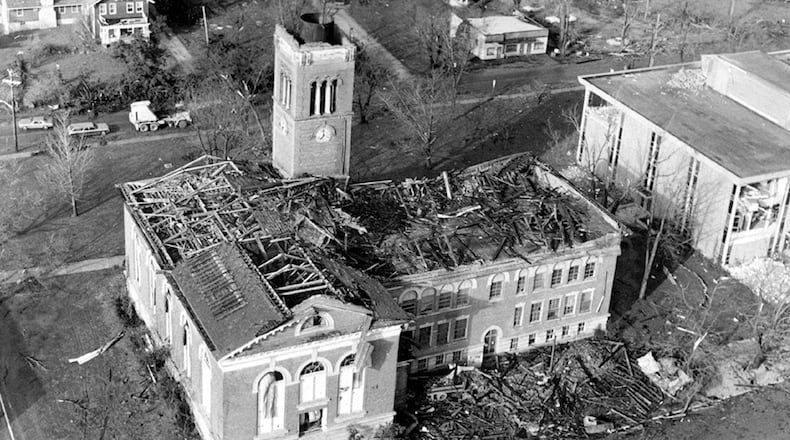• PHOTOS: 25 must-see images showing the destruction of the 1974 Xenia tornado
More could have been killed, a retired Wilberforce University librarian told the Dayton Daily News last week, had a night-shift worker not called Carnegie Library — which suffered tornado damage — to warn those in the building about the twister’s path.
“Central State was devastated,” Ohio Gov. and Greene County native Mike DeWine told the DDN recently, noting that he drove through that area the day after the tornado.
“They both got hit,” DeWine said of the two historically black universities founded in the 1800s. “You know, it took a major, major rebuilding effort to put them back to where they could move forward.”
The CSU destruction was so extensive that then-President Lionel Newsom said there was a “real danger” the school may permanently close or merge with another state university, according to DDN archives.
The tornado that hit after 4:30 p.m. April 3 was part of a Super Outbreak across several states. Aside from the fatalities, more than 1,300 sought hospital treatment, according to DDN archives.
The twister that caused wind speeds of up to 300 miles per hour tore through the county, cutting a devastating swath that left an estimated $100 million in property damage.
Nixon declares disaster
DDN reports later called it “the worst outbreak of tornadoes in recorded American history,” with the severity of the damage prompting a visit from then-President Richard Nixon, who declared several counties in the region — including Greene — disaster areas.
DeWine said it appeared that on his drive from Xenia the day after the twister came through, “it was literally like this tornado just followed route 42.
“Because coming out town, there was a furniture store. And that was devastated,” he added. “And then I got to Wilberforce and then saw how widespread the damage was there.”
CSU damage estimates were $18 million, according to DDN records, at a time when the average price of a gallon of gasoline in the U.S. was 53 cents.
The four killed in Wilberforce, according to CSU and county records, were: Evelyn Rockhold, 51, the treasurer-manager at the school’s Federal Credit Union; postal clerk Oscar T. Robinson, 44; student Laura Lee Hull, 19; and Ralph Smith, 51, a maintenance worker at Central State.
Credit: JIM NOELKER
Credit: JIM NOELKER
The CSU campus did not receive help from outside Wilberforce for about five hours, as debris reportedly kept emergency vehicles from responding, according to the university.
Newsom closed the university for 10 days, county library records show. WU resumed classes 12 days after the tornado, according to DDN archives.
Library warning call
Wilberforce alum and retired librarian Jackie Brown credited a call from night-shift worker Lynn Ayers to Carnegie for helping save the lives of about seven students and employees in the building.
“She called and told us to take cover because the tornado was in the path of coming to Wilberforce,” said Brown, a now 78-year-old Xenia resident.
Credit: CONTRIBUTED
Credit: CONTRIBUTED
“So, we had to take all the students downstairs in the basement of the library and wait there. And when we went to the basement, we all stayed in the hallway,” she said. “And someone just told us to go into the business offices.
“When we came out of that room, we had books (and) pop machines all over the basement hallway,” Brown added. “And if we had been in that hallway, I think we would not be here to tell anything about the tornado because it would have killed us.”
Had Ayers not called, she said, “I don’t think we would have gotten the students down in the basement as quick as we did because we did not have a television at that time in the library. We just went with how it looked outside.”
Emerging from the basement and leaving the building, she said, “it was a surprise to see the devastation. Trees down. Buildings down. Cars turned over — that type of thing.”
Several Wilberforce buildings were damaged or destroyed, according to DDN records. The damage to Carnegie was less severe than other buildings suffered, Brown said.
Security told the group to walk across the street, where the university was building a new campus. It was then, Brown said, that she saw “the devastation at Central State.”
The tornado destroyed 16 CSU buildings and damaged 26 others, county library records show.
The 2,200-student CSU campus had to be evacuated due to loss of electricity, gas and water due to the tornado, according to the DDN archives.
But many students chose to stay to help with cleanup efforts, according to the university.
Rebuilding and graduation
Newsom’s efforts for reopening and rebuilding were lauded, a 1984 DDN article states. He deflected the credit, noting other CSU administrators, trustees, and state and federal officials — including Nixon — played key roles.
But Newsom told the DDN in 1984, “I was determined Central would get back in operation as quickly as possible.”
CSU received about $23.5 million in state and federal aid, according to DDN accounts. About $8 million came from the federal government, this newspaper reported. The total included $6 million from the state appropriated for buildings planned before the storm hit.
“It was a long period of rebuilding,” said Alissa Paolella, CSU communications manager.
Nonetheless, the CSU senior class graduation ceremonies were held as scheduled in June, according to the school. Wilberforce, which at the time held graduation in April, cancelled its event, Brown said.
Instead, the estimated 180 WU seniors were told to return in August, when another ceremony was held, Brown added.
Meanwhile, the Wilberforce University campus served as a Red Cross disaster relief center, and the school’s cafeteria was opened to the community, Brown said.
The WU student center served as a temporary post office for the area while dorms and classrooms were used as training spots for mental health counseling and recovery, she added.
Central State also used the campus temporarily. Other area universities also assisted, according to CSU.
The University of Dayton offered to reopen its West Dayton campus, with dorm space for 400 students, a cafeteria, classrooms and a large green space.
Wright State University offered CSU students use of its library, and some students attended their Central State classes at the Fairborn school, according to CSU.






